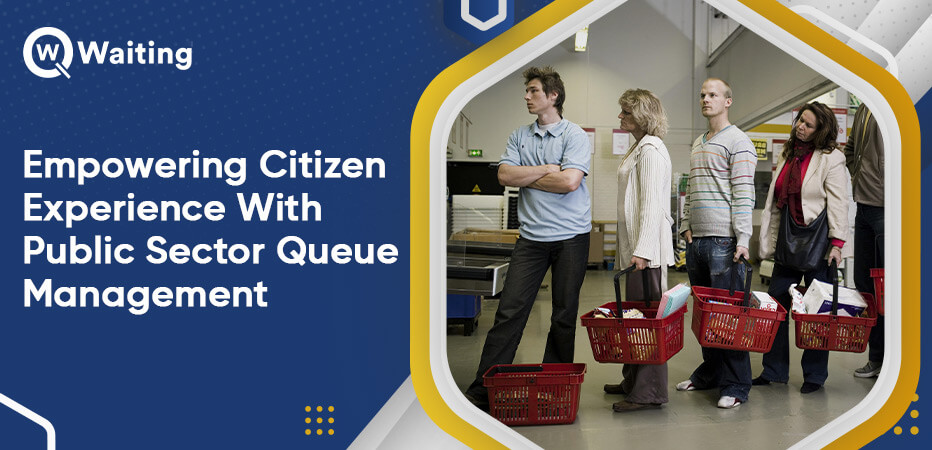
Queues can be a major source of frustration for citizens, causing dissatisfaction and negative perceptions of the public sector. I believe everybody reading this would agree. Long wait times, lack of transparency, and uncertain wait times can all contribute to a feeling of helplessness and annoyance. Crowded and disorganized waiting areas can also add to the frustration. Thus, it creates a stressful and unpleasant experience for citizens. Here, integrating a public sector queue management system comes as help.
It helps improve the citizen experience in the public sector by reducing wait times, improving organization and efficiency, and enhancing overall customer satisfaction. Such systems ensure citizens no longer have to stand in long lines for hours to be served. Instead, they can check in for their appointment and receive a text message or email notification when it’s their turn. Thus, proceed them directly to the service desk. This not only enhances convenience and saves time. It also increases transparency and accountability in the public sector, as wait times and service metrics can be easily monitored and analyzed.
How Does the Public Sector Queue Management System Empower Citizen Experience?
Improving citizen experience in public sector services can be achieved through efficient queue management. This involves implementing strategies such as:
Online booking and appointment scheduling
Online booking and appointment scheduling systems in the public sector are also known as queue management systems (QMS). These provide a convenient and efficient experience for citizens. It enables citizens to easily schedule appointments and access public services online. Thus, reducing wait times and saving time spent on administrative tasks. By empowering citizens to manage their own appointments, QMSs improve overall service delivery and satisfaction. This enhances the overall experience of citizens interacting with the public sector. As a result, it streamlines and improves the process.
Real-time queue updates and wait time estimates
Real-time queue updates and wait time estimates in an online queue system greatly improve the citizen experience. It provides them with accurate and up-to-date information on the current wait time and progress of their request or service. This allows citizens to plan their time more effectively and avoid long wait times. Thereby, reducing frustration and improving overall satisfaction with public sector services. The feature can also help public sector queue management better manage their resources and prioritize requests based on the current demand. It results in better and more efficient use of resources.
SMS and email reminders for booking
SMS and email notifications for appointment reminders and updates assure timely and convenient communication. It notifies customers about their appointments and updates on their requests or services. This feature helps citizens stay informed and on track. Thus, reducing the likelihood of missed appointments and missed opportunities to receive the necessary services. Also, it helps public sector queue management improve its operational efficiency by reducing no-shows and ensuring more effective use of resources. Furthermore, these notifications can also help to reduce frustration and increase satisfaction among citizens by providing them with the information they need in a timely and convenient manner.
Interactive kiosks for self-service check-ins
Interactive kiosks for self-service check-ins enable citizens to check in on their own. It reduces wait times and frees up staff resources for more complex tasks. Interactive kiosks also provide citizens with real-time updates on the status of their requests or services. As a result, it increases transparency and reduces frustration. Additionally, self-service kiosks can help public sector organizations improve their operational efficiency by reducing administrative workload and enabling staff to focus on more important tasks. This feature empowers citizens to take control of their experience and effectively manage time while receiving the necessary services from the public sector.
Queue prioritization for special individuals
Queue prioritization for elderly, disabled, and vulnerable individuals is available too. Such a queue management system helps public sector organizations provide an equitable and inclusive experience for all citizens. Regardless of their physical abilities or needs. This feature can help to reduce frustration and stress among the elderly, disabled, and vulnerable individuals. Thus, improving their overall well-being and sense of security. In this way, QMSs that prioritize the needs of these individuals can empower the citizen experience in the public sector queue management and improve access to essential services for all citizens.
Mobile solutions for remote access to queue services
A queue management system is a mobile solution for remote and on-the-go access to queue information and services. It enables citizens to check their place in line and receive real-time updates on the status of their request or service. Also, the citizens can check in for appointments from anywhere, at any time. This increases flexibility and control for citizens, allowing them to manage their time effectively and reduce frustration. By providing remote and on-the-go access to queue information and services, mobile solutions empower citizens to take control of their experience and receive the necessary services from the public sector conveniently and effectively.
Conclusion
In conclusion, effective queue management in the public sector can greatly enhance the citizen experience by reducing wait times, improving customer service, and increasing efficiency. I would recommend implementing queue management software like Qwaiting. It can provide a streamlined and organized system for managing queues and tracking customer flow. The software can also provide real-time data and analytics to help organizations make informed decisions about resources and operations. Additionally, the software can be customized to meet the specific needs of different public sector organizations, making it a versatile solution. In short, queue management software is a valuable tool for empowering the citizen experience and promoting efficiency in the public sector.
